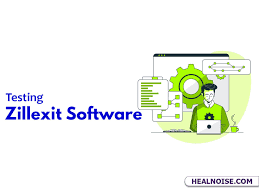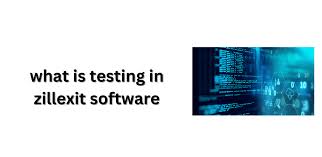Introduction
In the fast-paced world of software development, ensuring that a product functions as intended is paramount. This is where testing comes into play, especially in a sophisticated platform like Zillexit Software. But what is testing in Zillexit Software? Let’s dive into the details.
Understanding Zillexit Software
What is Zillexit?
Zillexit is a cutting-edge software platform designed to streamline complex business processes. It integrates various functionalities to provide a seamless user experience, making it a popular choice among enterprises looking to enhance their operational efficiency.
Core Functionalities of Zillexit
At its core, Zillexit offers features such as project management, customer relationship management (CRM), and data analytics. Its versatility allows businesses to customize the software according to their specific needs, making it a robust tool for diverse industries.

The Significance of Testing in Software Development
Why Testing is Crucial
Testing is the backbone of software development. It ensures that the software performs reliably under various conditions. Without thorough testing, software can be prone to bugs and glitches, leading to user dissatisfaction and potential financial losses.
The Impact of Untested Software
Imagine launching a product without testing—users encounter errors, data gets corrupted, and the entire system could crash. Untested software can severely damage a company’s reputation and bottom line. Therefore, rigorous testing is essential to deliver a high-quality product.
Types of Testing in Zillexit Software
How It’s Performed in Zillexit
In Zillexit, unit testing is performed using automated scripts that check the functionality of each module.
Integration Testing
Definition and Purpose
Integration testing focuses on verifying the interaction between different modules or components. It ensures that the combined parts work together as expected.
How It’s Performed in Zillexit
Zillexit uses a combination of automated and manual testing to check the integration of various components.
System Testing
Definition and Purpose
System testing evaluates the complete and integrated software product to ensure compliance with the specified requirements.
How It’s Performed in Zillexit
System testing in Zillexit involves testing the entire system’s functionality, performance, and security. It ensures that the software works as a whole.

Acceptance Testing
Definition and Purpose
Acceptance testing is the final phase of testing, where the software is evaluated in a real-world scenario to ensure it meets the business requirements.
How It’s Performed in Zillexit
In Zillexit, acceptance testing is performed by end-users who validate the software’s functionality before it goes live. This step is crucial for ensuring customer satisfaction.
Automated Testing in Zillexit
What is Automated Testing?
Automated testing uses software tools to run tests automatically, reducing the need for human intervention. This method is highly efficient for repetitive and regression testing tasks.
Benefits of Automated Testing in Zillexit
Automated testing in Zillexit increases test coverage, improves accuracy, and speeds up the testing process. It allows for continuous integration and delivery, ensuring that new features are quickly validated and released.
Manual Testing in Zillexit
What is Manual Testing?
Manual testing is done by human testers who run test cases manually, without using automation tools. It’s crucial for exploratory, usability, and ad-hoc testing.
Benefits of Manual Testing in Zillexit
Manual testing in Zillexit provides a human touch, ensuring that the software is user-friendly and intuitive. It helps in identifying issues that automated tests might miss, such as visual and user interface glitches.
Testing Tools Used in Zillexit
Overview of Popular Testing Tools
There are numerous testing tools available in the market, each designed for specific testing needs. Some popular ones include Selenium, JUnit, TestNG, and Postman.
Specific Tools Used in Zillexit
Zillexit employs a range of tools to ensure comprehensive testing. These tools help in maintaining high standards of quality.
Best Practices for Testing in Zillexit Software
Planning and Designing Tests
Effective testing begins with thorough planning. Test plans should outline the scope, objectives, and resources required. Designing test cases that cover all possible scenarios is crucial for thorough testing.
Executing and Documenting Tests
Executing tests methodically and documenting the results is essential. This helps in tracking progress and identifying areas that need improvement.
Analyzing and Reporting Results
After executing tests, analyzing the results helps in understanding the software’s performance. Reporting these results to the development team aids in making necessary corrections and enhancements.
Challenges in Testing Zillexit Software
Common Obstacles Faced
Testing in Zillexit can be challenging due to its complex architecture and integration capabilities. Common obstacles include handling large datasets, ensuring cross-platform compatibility, and managing frequent updates.
Strategies to Overcome These Challenges
Overcoming these challenges requires a strategic approach. Implementing continuous integration and delivery, using robust testing tools, and involving end-users in the testing process can significantly improve the outcomes.
The Future of Testing in Zillexit Software
Emerging Trends
These technologies can predict potential issues and automate even more complex testing scenarios.
Potential Advancements
The integration of AI-driven test automation and predictive analytics will make testing more efficient and effective.

Conclusion
Testing is a critical aspect of Zillexit Software development. It ensures that the software performs reliably, meets user expectations, and maintains high quality. By understanding the different types of testing and employing best practices, businesses can deliver superior products and enhance customer satisfaction.
FAQs
What is Zillexit Software primarily used for?
Zillexit Software is used for streamlining complex business processes, including project management, customer relationship management (CRM), and data analytics.
How often should testing be done in Zillexit?
Testing in Zillexit should be continuous, especially with frequent updates and new features.
Can testing in Zillexit be fully automated?
While many aspects of testing in Zillexit can be automated, manual testing is still necessary for usability and exploratory testing to ensure a user-friendly experience.
What are the most common bugs found during testing in Zillexit?
Common bugs include integration issues, data inconsistencies, user interface glitches, and performance bottlenecks.
How can I start testing in Zillexit Software?
To start testing in Zillexit Software, you should begin with a thorough understanding of the software’s functionalities, plan your test cases, and use appropriate tools for automated and manual testing.










